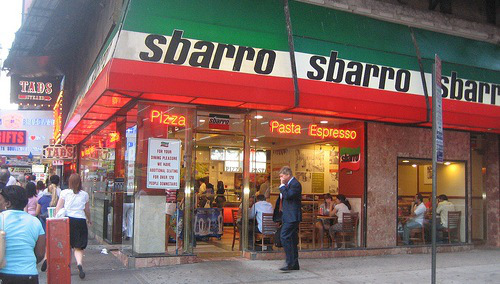There’s a fascinating trend going on in the junk food world. Whether or not you eat at burger and pizza joints, it’s one that’s worth paying attention to because it’s likely to have ramifications on how food is bought and sold everywhere.
Sbarro is the latest to go upmarket, the Wall Street Journal reports, following a trend started a few years ago by McDonald’s. The “Italian food” chain (I use the term loosely so as to avoid offending Italians, who doubtlessly find Sbarro’s food as repugnant as I do) is looking to raise the quality of its offerings thanks to “technological changes.” Outlets will now be able to make fresh tomato sauce and shredded cheese on site, rather than relying on prepackaged goods. That might actually result in pizza that doesn’t taste like the bottom of someone’s shoe.
Taco Bell has been doing the same thing for much of this year, with a new, fancier menu featuring better ingredients designed to compete against Chipotle, not to mention a revamp of restaurant locations that’s already under way. They’re all following McDonald’s lead, which has seen improved financial results on the backs of “premium” burgers, smoothies and salads, plus a massive revamp of restaurants.
With better profits based on premium products beckoning, there seems to be a big hole opening up at the bottom. As the WSJ puts it, who will be left “to champion the cause of good old fashioned junk food, sold at junk prices?”
Burger King recently moved to fill that niche with marketing aimed at the traditional fast-food demographic, as in young men. But with franchisees begging the company not to alienate other customer segments - including women - and the allure of other chains’ higher profits, it’s likely only a matter of time before Burger King joins the crowd.
Americans currently spend about 6% of their monthly incomes on food, so the upmarket trend in fast-food means one of two things. Either the public is becoming increasingly willing to see that percentage rise, or if that’s not the case, there will be a large void left as the biggest chains chase the smaller minority that do want to spend more.
That second scenario seems more likely, which means that an opportunity is opening up for someone to come in and cater to people who don’t want to spend a lot of money on food. Could this mean that my dream of a robot-operated fast-food joint might finally become a reality?
In the larger sense, if the bigger chains are content to sell less product at a higher profit, that could mean a lowering of demand on food. That could ultimately be good news, as it could translate into cheaper beef, chicken, potatoes and other goods. Of course, if the big chains want to maintain the same volumes but at higher prices, things could easily go the other way instead.


Marc Venot
October 18, 2012 at 1:34 am
To reduce the price of food it will need to go to stem cells (Nobel prize of medecine this year), and as you said robots.